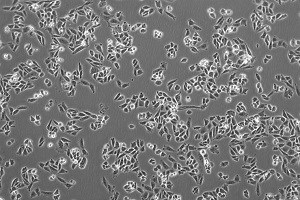Cell Line Profile CHO-K1
(ECACC catalogue no. 85051005)
Cell line history
The CHO-K1 cell line is a sub clone of the original CHO cell line, first initiated in 1957 by T.T. Puck and colleagues at the Department of Biophysics, University of Colorado Medical School in Denver, USA. The original cell line derives from a biopsy of an ovary of an adult Chinese hamster1.

CHO-K1 cells 6 hours post seeding
Key characteristics
Cell morphology is epithelial with cells requiring the addition of Proline to the media due to the absence of the gene which synthesises proline. This leads to a block in the biosynthetic chain at the step where glutamic acid is converted to glutamine gamma serialdehyde2.
In 2012 data was presented for the genomic sequence of CHO-K1 cell line, which comprises 2.45Gb genomic sequence with 24,383 predicted genes. Interestingly many genes were identified which are involved in glycosylation. This is a major factor which affects therapeutic protein quality and virus susceptibility genes. Many viral entry genes present in the genome were found to not be expressed, which may explain why many CHO derived cell lines show considerable viral resistance3.
Culture tips
Cells are cultured in Ham’s F12 which has the necessary amount of proline added to the media. To avoid clumping, do not agitate cells by hitting or shaking the flask whilst waiting for the cells to detach.
Applications
CHO cell lines and their sub-clones are useful in many applications as they can be genetically manipulated to grow as either adherent or suspension cells. They also have an established history of regulatory approval for therapeutic recombinant protein production4. This has resulted in these cell lines playing a dominant role as host expression systems for a broad range of products such as growth factors, hormones, monoclonal antibodies, interferons and enzymes1. They are also widely used for in vitro cancer studies, particularly for ovarian cancer5.
CHO-K1 cells have sown virus susceptibility3 and have also shown resistance to poliovirus 2, Modoc virus and Buttonwillow virus.
|
Related cell lines |
ECACC catalogue number |
Description |
|---|---|---|
|
CHO |
A subclone of the parental CHO cell line |
|
|
CHO-K1-AC-free |
Hamster Chinese Ovary, serum-free |
|
|
CHO (PROTEIN FREE) |
Chinese hamster ovary have been adapted for growth in Sigma CHO Protein Free Medium (C5467) |
|
|
CHO-K1/SF |
Hamster Chinese ovary (MEM adapted) used in Pertussis Toxin research and for quality control of batch production |
|
|
RR-CHOKI |
Derived from the parent line CHO-KI, resistant to ionising radiation and UV irradiation |
Key References
-
Puck, T. T., Cieciura, S. J., & Robinson, A. Genetics of somatic mammalian cells: III. Long-term cultivation of euploid cells from human and animal subjects. Journal of Experimental Medicine, 108, 945– 956 (1958)
-
Gamper, N., Stockand, J. D., & Shapiro, M. S. The use of Chinese hamster ovary (CHO) cells in the study of ion channels. J Pharma & Tox Methods. 51: 177-185 (2005).
-
Xu, X. et al. The Genomic Sequence of the Chinese Hamster Ovary (CHO) K1 cell line. Nat Biotechnol, 29(8): 735-741 (2012).
-
Kang, S. et al. A novel regulatory element (E77) isolated from CHO-K1 genomic DNA enhances stable gene expression in Chinese hamster ovary cells. Biotechnology Journal. 11: 633-641 (2016).
-
Jacob, F. et al. Reliable in vitro studies require appropriate ovarian cancer cell lines; J Ovarian Res. 7(60) (2014).
